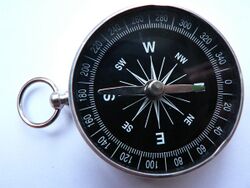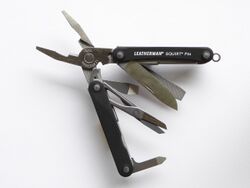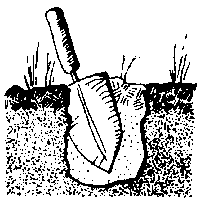Engineering:Ten Essentials
The Ten Essentials are survival items that hiking and Scouting organizations recommend for safe travel in the backcountry.[1][2]
The Ten Essentials first appeared in print in the third edition of Mountaineering: The Freedom of the Hills (January 1974).[3] Many regional organizations and authors recommend that hikers, backpackers, and climbers rigorously ensure they have the ten essentials with them. However, personal preferences and differences in conditions may dictate otherwise and with experience most adventurers add and subtract from the list depending on the situation.[1] Some ultralight backpackers do not always carry all of the items and believe it is an acceptable risk they take in order to travel light and fast.[4]
List
The ninth edition of Mountaineering: The Freedom of the Hills, published in 2017, defines the Ten Essentials as:
- Navigation: map, altimeter, compass, GPS device, personal locator beacon
- Headlamp: with LED bulb and spare batteries
- Sun protection: sunglasses, sun protective clothing, sunscreen
- First aid: a first aid kit, wrapped in waterproof packaging
- Knife: hikers on a short trip may also carry a multi-tool, strong adhesive tape and cordage; on a longer trip, further small tools may be useful
- Fire: the means to both start and sustain a fire; either a butane lighter or matches, or other fire making device. Firestarters for igniting even wet wood, and in areas where no firewood will be available, a stove is highly advisable.
- Shelter: plastic tube tent, jumbo plastic trash bag or bivy sack
- Extra food: at least one day's food for a short hike, that should require no cooking.
- Extra water: drinking water and the skills and tools to purify water
- Extra clothes: additional items may be needed if spending the night in the emergency shelter
The first five items are intended to prevent and respond to emergencies, the second five to safely spend one or more nights outdoors.[5]
Other lists
Other outdoor organizations have variations of the Ten Essentials pertinent to local conditions.
Boy Scouts of America's "Scout Basic Essentials" are quite similar (Map and Compass, Sun Protection, Extra Clothing, Flashlight, First-Aid Kit, Matches and Fire-starters, Pocketknife, Trail Food, Water Bottle, and Rain Gear.)[6]
Utah's Wasatch Mountain Club lists extra water in place of food, as Utah is mostly desert terrain, and water is more difficult to find.[7]
The Spokane Mountaineers list "thirteen essentials", which supplement the list with emergency shelter such as a space blanket, signaling device, and toilet paper and trowel (for sanitary disposal of human waste; the toilet paper also doubles as tinder for starting a fire).[8]
The "Ten Essential Groups" is an alternative approach to essential gear selection.[9] Items from each group should be chosen depending on the season, geographic location, and trip duration. In 2011, Columbia Sportswear adopted the "Ten Essential Groups" concept for their iOS app "Take Ten to the Greater Outdoors".[10]
Central Arizona Mountain Rescue Association promotes the 12 Essentials, which includes Signaling Devices and Personal Items.[11]
See also
- Bow drill
- Camping
- Dehydration
- Emergency shelter
- Hiking equipment
- Hyperthermia
- Hypothermia
- Mini survival kit
- Navigation
- Orienteering (scouting)
- Pioneering (scouting)
- Solar still
- Survival kit
- Survival skills
- Thermal insulation
References
- ↑ 1.0 1.1 "Ten Essentials". Great Outdoor Recreation Pages. http://www.gorp.com/hiking-guide/travel-ta-hiking-wilderness-skills-sidwcmdev_058018.html.
- ↑ "Ten Essentials". National Park Service. https://www.nps.gov/articles/10essentials.htm.
- ↑ "What Are The Ten Essentials?". The Mountaineers. https://www.mountaineers.org/blog/what-are-the-ten-essentials.
- ↑ Jardine, Ray (2000). Beyond Backpacking: Ray Jardine's Guide to Lightweight Hiking. AdventureLore Press. p. 124. ISBN 9780963235930.
- ↑ Mountaineers, The (5 October 2017) (in en). Mountaineering: Freedom of the Hills (9th ed.). Mountaineers Books. ISBN 978-1-68051-005-8. https://books.google.com/books?id=vyE6DwAAQBAJ. Retrieved 16 January 2021.
- ↑ "Packing Checklists for Camping Trips". 16 May 2017. http://boyslife.org/outdoors/outdoorarticles/6976/scout-outdoor-essentials-checklist/.
- ↑ "Precipitation in Utah". http://www.wrcc.dri.edu/narratives/UTAH.htm.
- ↑ "The 13 Essentials of the Spokane Mountaineers". Spokane Mountaineers. http://spokanemountaineers.org/public_html/trip_lead_essentials.htm.
- ↑ "The Ten Essential Groups". Dallas Sierra Club. http://texas.sierraclub.org/dallas/page.asp?10essentialgroups.
- ↑ "Take Ten to the Greater Outdoors". Columbia Sportswear. https://itunes.apple.com/us/app/take-ten-to-greater-outdoors/id412088534.
- ↑ "Central Arizona Mountain Rescue Association". 2018-03-20. https://www.mountainrescue.org/tips.
External links
- "New Ten Essentials". Mountaineers Books. http://www.mountaineersbooks.org/Assets/ClientPages/zz_TenEssentials.aspx.
- Wood, T.D. (2014-02-18). "The Ten Essentials". REI. http://www.rei.com/learn/expert-advice/ten-essentials.html.
 |




